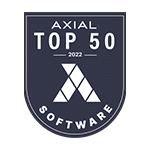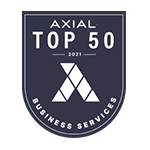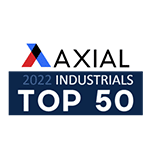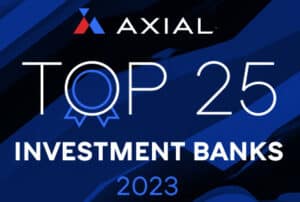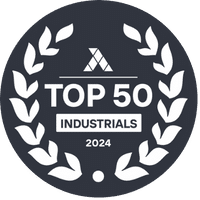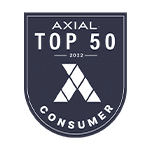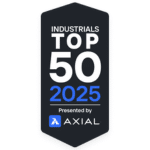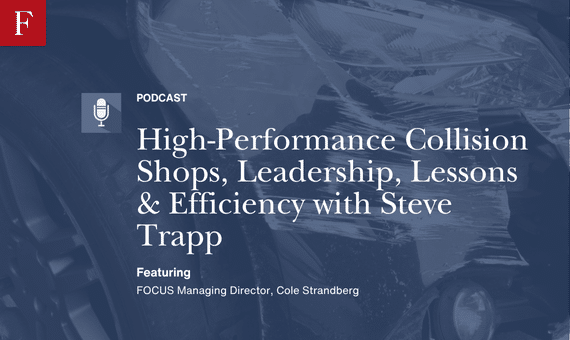
High-Performance Collision Shops, Leadership, Lessons & Efficiency with Steve Trapp
On this week’s episode, Cole Strandberg chats with returning guest Steve Trapp, and they talk about what true efficiency really looks like at the shop level. From flow and quality standards to management presence, goal setting, productivity coaching, and capital planning. This episode is packed with real-world takeaways you can use right now to run a more disciplined, high-performing shop.
Listen and Follow The Collision Vision.
Cole Strandberg: So if you missed us last month with Steve, we talked all about some of the marketing basics during our marketing series. It so happens that Steve is not only an expert in marketing, he’s also an expert in process and optimization or process optimization rather. So excited to dive into that today. Steve, I’ll, I’ll jump right in. You’ve worked with hundreds of shops across the country, many of whom have been represented here on the Collision Vision. What does efficiency really mean in a modern collision repair environment?
Steve Trapp: It’s funny, years ago my the very first Paint 20 group I ever did, a guy named Ed Moore was bald at the time he were in his fingers across the scalp and he goes. My shop has 2000 hours available to sell every month He goes If you’re only doing 2000 hours in a month, I don’t really care about your opinion of this meeting. I want to know who’s doing 3 to 3020 thirty 500. I want to hear the ideas You have to be more useful of that time because ultimately those techs are going to make more money if they’re efficient. And so, you know, a lot of these people are out there pushing repair over should be replace over repair. And there’s no way you can do replacement very much faster than 115 to 120% efficient. But judgement time with a lot of the cool techniques, we can get 165 to 250% efficiency. So those texts, what they really thought about it would be better off to look at repair options. But again, they can’t flip as many cars, but they’re making a lot more hours. So the efficiency in this day and age is what tools and techniques can I do if I have a fully kitted repair plan, repair plan and cart full of parts so I can just keep working on that car and the more time I can spend in my stall with a tool in my hand making money. That’s efficiency in 2025.
Cole Strandberg: There you go and thrive in 2025 as we left off last month. I think that’s important to keep in mind. Something in our pre show call we talked about was the importance of managing by data and structure rather than building your operation and managing your operation on gut feel. Why is it important to have that data and to manage actively with that data?
Steve Trapp: Yeah. So if you think about it, yeah, I use the numbers efficiency analogy a minute ago, but ultimately, you know, cycle time efficiency, whether it be quality control scores, all those things kind of an indication of how we’re we’re we’re doing our our whip versus our optimal whip, our amount of cars in the hospital that are waiting and pending approvals or something. All that data really can help us make better decisions on what cars to prioritize. So we keep a level flow. So my brother shop, we’re always looking for five cars in and five cars out a day. He does about 20 hours per car. So that means 100 hours per day come in and out of each department. So paint hands, 100 total hours to the reassembly body hands, 100 hours to paint. So again, having those numbers available so that you you are looking at flow because you’re really trying to optimize each department each day.
Cole Strandberg: I want to lay the groundwork on our efficiency conversation and start kind of with the basic pillars of that word. And so talk to me about the importance of a consistent and level repair flow as the first step to real efficiency.
Steve Trapp: Yeah. So if you think about it flow and the number I just used was really derived from a total sales goal. So in my brother’s shop’s example, that number it’s about 350,000 and he does about 28% in paint labor. OK, divide that by the shop, right. And that’s how we came to the 100. His cycle time goal is right now 8 to 10. OK. So he’s, he wants to have basically if each, you know, we’re trying to keep an optimal whip in the shop of around 800 to 1000 hours. OK, when we get over 1000, we’re going to have an 11/12/13 day cycle time, which is bad. There is a directly proportional relationship between the number amount of vehicles in WIP and your and your cycle time. Because if you can output only 100 hours a day, if you have 800 hours, it’ll take 8 days in cycle time. If it’s 100 hours a day and there’s 1000, it’ll take 10 days in cycle time. It’s directly proportional. A lot of shop owners don’t understand that and so they love to fill their lot with cars thinking that’s what keeps their techs motivated. That is just going to kill their their their cycle time and lead to more cars in the hospital and more upset, unhappy customers.
Cole Strandberg: No question about it. You also in our pre show call, I, I should have hit record on that pre show call because it was packed full of value here too that we’ll expand on here today. But you mentioned the importance of daily production goals that are going to tie back into larger KPIs and and longer term KPIs. Talk to me about why that is and what we should be kind of looking at when we look at these goals.
Steve Trapp: So I’m, I’m a big believer in having a, a production walk at the end, at the end of every day. And you’re basically pulling work from the previous department to make sure you hit that number so that I use the number 100. Let’s just keep using that. So we want to look for 100 hours. We can pull from reassembly to detail to deliver tomorrow. We want to look in the paint shop and say what can we pull from paint into reassembly so I can reassemble 100? What body jobs can I get over here to get me my 100? And I’m planning ahead because I may have two or three heavy hits that are going to take a couple days. So what other jobs going to get around them? So that that that allows the text to keep working on the heavies. And then of course, repair planning and parts gathering is important. But the whole idea here with this is to ultimately have daily goals per department. And So what I would do is sit down again at noon and have what I call a production huddle and say, how many hours did we actually move from one department to the next? If we’re 50505050 and everybody’s moved 50, we’re good. But if one department say reassembly is way behind, we may need may need to pull people from either reassembly or super from disassembly or from body to try and make up that that let’s say a 10 or 20 that we only got done this morning. So it’s super important to have those KP is in mind and and it’s really important that the techs understand that themselves. It doesn’t have to be super manager making those decisions. If you just look at the numbers again going back to your KPI, just thought is just let the numbers guide your behavior in the afternoon and how do we going to get those 100 hours out between departments. So that’s a short answer I guess.
Cole Strandberg: That’s perfect right down the middle answer. From my perspective, regardless of of what it is, change creates at least a short term inefficiency. Even when we’re in the pursuit of of change that’s going to create mid and long term efficiency. How do you get buy in from the team when changes might equate to, at least at first, a slower car count or just a lack of production from their perspective?
Steve Trapp: That’s a great question ’cause if you think about it, nobody wants to change. So the guy who is the CEO of Airstream came up with a slogan. It says we don’t make changes, we only make improvements. OK, So the idea is we’re going to try it. OK, again, air quotes, try it and just try it for a while and tell me what you think of it. And let’s see what we need, what we could do to improve the process. But I’d like for you to try it this way for a while. That way you’re not saying I, you know, I’m going to mandate this to be done. I’m saying I think this will help. It was an idea I heard and I, I’m going to share with you guys today. Hopefully you like it, but let’s try it for a while and then tell me what your feelings where I can tell you that the whole concept of and Mike Anderson tried to teach my my brother’s shop this whole 100% disassembly and the guys were snowmobiling with me and they’re all like, I ain’t doing that because you realize it’s five days later. I’m trying to put a difficult complex front end together and I’ve only seen one of these Nissan’s in my life. And now I got to try and put it together five days later. I don’t remember where half that stuff goes. So they left the assemblies together. So we made a change and that was to basically use the imaging upfront, getting images right with AI upfront so parts could be ordered. So now that sheet metal was there, the complex lift gate, the complex door, the complex bumper is there at the shop. We, we wait for the car to show up, we verify our color, get it painted and then bring it over and then we transfer those parts. So that was a moment where the text said, I’ll try that because I think that will work. And their productivity or efficiency, however you want to refer to it went up 15%. And it wasn’t me telling them that they were going to get a 15% efficiency improvement. It was me try this and let’s see what happens. And we measured it going back to your measurement idea. And they realized, Oh my gosh, that worked really well. And now I they literally put the same bolt in the same hole on the new part that it was in the old part and there was no, you know, lost things. Then we were able to test wiring looms. We were able to test whether the headlights hue was the same color as it needed to be. And if we need to get another one, we had the entire time while the vehicle was repaired to get that done. So I think changing some process or improve, to use the term improving some process would really help the shops in in getting these these and improved performance results. I think a lot of shops got very complacent with the way they’ve always done it and they really, they see these new ideas like, oh, that seems like that seems hard. Sometimes things that are a little harder are actually quite beneficial. So try it.
Cole Strandberg: There you go. We might see a a bit of AJ curve, right, might go down before it goes up, but you’re gonna have some feedback and say in that and and some team buy in is key to culture. Last month in our marketing conversation, we talked about culture and buy in and communication from the team when it came to a customer experience. I want to go down a similar path but talk about quality and So what are your tips for setting and communicating some quality standards across these multiple departments to make sure we have one great outcome?
Steve Trapp: Yeah, I would say this, if your quality control sheet has like 25 things for a specific department, it’s thorough, but it’s just going to get a line right through it because they’re not going to look at those individual lines. They’re going to basically be looking to to just move that vehicle to the next department. And just saying that’s just way too many details. I know how to fix cars, right? I’m just going to zip past it. So having 5 or 6 things that are super important that maybe have popped up recently on quality control sheets that quality control inspections that are is a good thing and just basically reinforcing and having those things written down. So it’s the the quality standard that’s expected. But to basically make a huge quality control checklist hasn’t worked. It’s quality assurance, which means the quality is built into the process. If we have to have a downstream inspector looking at it and we aren’t expecting perfection from our people, they’re not going to deliver perfection. So I’m a big believer and a lot of people I work with are big believers in basically let’s set quality standards and have quality assurance. So the people basically assure they deliver proper quality and they understand the OA certifications, the only requirements that were necessary to fix the car and return to pre law, same shape and form. I mean they’ve got to know those things. And then having a standard, let me give you a perfect example is one of the things that a shop in Madison, WI did and it wasn’t my brother shot was another guy. I was sitting there trying to describe the, the movement between the body and the paint shop. And we kind of describe what you know, what a what primer ready sounded like. He goes, why don’t we just make that the standard and then you guys prime it won’t get it primer ready. The problem he had was he would get it in his mind primer ready and then somebody over a proper over in the in the in the prep area would hit it with ADA and change the shape of the of the, of the surface. And they’re like, why do I care? You’re going to hit it with the DA anyhow and screw it up. So the idea is that having a standard primer ready was important. So I think at whatever department is, it has a have a quality standard, reinforce it frequently. The big key here is 4 to 1/4 positives for everyone negative. So you’ve got to catch them doing it right. So inspecting as many cars as you can as they move from department to department is essential to building the a positive thing, a positive culture, to use your term to, to really then say, OK, in this case we didn’t quite meet our standard. What could we have done better? What could we do in the future so we get the the the positive feedback that we’re all looking for?
Cole Strandberg: I like the four to one. I’ve heard the compliment sandwich, which would imply 2 to one, but 4 to 1, I like those odds even better. I love talking with you Steve, because you introduce and frame some stuff that might not be so simple in a very simple, understandable, digestible way. And and one such example of that is a pre show call where you talk to me about a new concept that I was not familiar with called management by walking around. It doesn’t sound super complex. Talk to me about that in the context of of running a shop and leaving a shop.
Steve Trapp: Yeah. So obviously if you look at a day of a production manager, they have the responsibility of delivering quality work, work to the to the to the office that that to meet the expectation. They also have the responsibility of doing it right. They have the responsibility to to do it on time. They have the responsibility of making sure that the shop is safe and people are safe. The best way to do that, however, is to just say during that time between moments where you’re updating computers or you’re doing some specific tasks, walk around and look for ways that you can remove barriers. Whether I call them hospital cars, they’re cars that are basically are stuck waiting for a national back order parts. So get with the parts person, say what can we do to get it that part? Could we go to a salvage yard? Could we even go to the dealership and ask them to take a vehicle apart and and give us that part? Can we drive somebody, have somebody drive somewhere and grab the part? You know, what do we got to do to get that thing moving? OK, that’s number one. Number two would be looking for equipment that’s maybe not performing up to standard. Look for people that could be better utilized and and doing different things. So your job and during management walking around is going up to as many every car every day and talking to the techs. And so management walking around also involves building relationships with those techs and saying, hey, what could we be doing better to help you do better? Whether it be equipment, equipment, it could be training, it could be communication, it could be getting parts to you. But that’s your job is to really be a manager and listen to your people, get to know them and get them to give you their ideas. Any good consultant will tell you the best ideas are the ones that come from the people that are working in the process. Having somebody from the outside bring crazy, you know, ideas, and it just leads to people being a little confused where if you take the good ideas they have and just implement them successfully, sometimes it’s better.
Cole Strandberg: I feel like in walking around, there are a lot of things that would cause you to lose some focus. Obviously you want to talk and get feedback, but you also want to look at certain things, I would think. And what should those important things that a manager should be looking for as they’re walking around include?
Steve Trapp: Well, obviously you look for ways in which the people in the shop could be more productive. If you notice that they’re may be looking for a tool, waiting for a part, waiting for approvals, they’re waiting for paperwork. They’re they’re, they’re sharing a tool or they’re using a tool that’s not working to its up to its standard. You’re just looking for anything that is slowing them down and that’s making them be the not be the best they can possibly be. And you know, again, listening to them and doing that. But it also involves vehicle flow and it says I need 100 hours a day from each department. You’re now working on something, probably doing something I don’t need done right now because the paint shop is about to run out of work. I need you to redirect over here for a short period of time. So you’re really looking for flow. You’re looking for opportunities to to make the process better. You’re looking for ways to get them to communicate with each other and with the office. You’re just looking for opportunities to make the process a little bit better or improve it like we talked about.
Cole Strandberg: At the top of the show, we talked a little bit about managing not with your gut, but with data and creating action items from that data. My mentor always told me if you can’t measure it, you can’t manage it. And I I believe that to this day. So how do you introduce productivity goals that are quantifiable? Not not qualitative, but quantitative to your team in a constructive way, where those expectations can be set in a very binary way.
Steve Trapp: So let’s take the hourly person that’s new to the trade, OK? The best way to do that is to sit down. There’s some simple math that I can share with you, but basically it’s taking the the total cost of the person divided by the 100% minus the gross profit goal. So if you’re trying to shoot for 60 / .4 or 40 and then divide that by the labor rate and that’s going to tell you how many hours that they need to produce. So let’s say they’re a $20.00 an hour tech and they need to produce 80 or to me 30 hours in a 40 hour week. Or you know, maybe a little more expensive, they’re a $30 person. They would make 40 in a 40 hour week. The idea is to give them that number OK and say it is Monday. You’ve got 5 days and you you’re trying to let’s use 30 is math simple. That means in each day I need for you to to basically do six hours worth of collision repair work. So that tailgate over there pays 4. This door over here pays 2 and let’s go ahead and do that and let’s see you know what when you get that done and if you get it done before the end of the day. Because by breaking that down to either by shift or by, by half days and saying, are you doing the most effective way of, of, of doing this? The idea then is to partner them up with a mentor and say, I don’t need you to show me how to do the work. I need you to tell me how, how that Honda door panel comes off easiest or doesn’t damage it. What, what are some ways in that lift gate where, how do those hinges work? And maybe show me those things, those little tricks so that I, when I do this myself, I can do it to the standard you set for me. And so a big part of mentorship isn’t basically them just working as an assistant, watching it and picking it up. It’s saying, I have 4 hours to do this. What are what are some ways that I can learn to be more productive or efficient in doing that? If you’re a flat rate tack, it might be you set a goal for 60 hours and you’re saying, all right now in a 40 hour week, you got to get 60 hours because if I’m going to give you 2 stalls or a stall and 1/2, I need to get a return on my investment. And if you’re, if you’re only doing 40 in a 40 hour week, I can’t give you 2 stalls because it ties up a lot of productivity. So it really does tie again back to your KPIs and, and really trying to set goals for them so they know, you know, if you want to make X amount of money, make your house payment, your car payment, your boat payment, and you know, whatever other payments they have, you need to turn this many hours. So let me get you those hours and let me get you an opportunity to fix those kind of cars so you can make that kind of money.
Cole Strandberg: I love it. We talked about the importance, or at least the the greasing of the wheels for buy in when you get a team’s input and feedback in real time. I think at the bare minimum though, table stakes are for them to understand the why behind what you’re having them do. So how do you ensure that your team understands the why behind your expectations?
Steve Trapp: So if you’re like me, sometimes it’s very easy to go from point A to Point C, in other words, to give them the answer to the question. And it’s so it’s so, so easy to do because you might know the answer to the question. You’ve been doing it for a long time. The better approach is to say, what do you think we should do? And you hope that the little voice in the in their head is your head. It is your, is your voice and you’ve been telling them the what and the why for a long time. And now they’ve internalized it and they see that as what is obvious to them. And they see the why and because they’ve been told that if they’ve never been told the why, it’s incumbent on you to know the why. And if the person that shared the cool idea with you when you first heard it, that didn’t share, it’s incumbent on you to go back and say, can you help me with the why? So if I get asked that question, I can answer it properly and, and in a timely manner. So they can go right back to him and say here’s why we suggest that. Here’s why that’s beneficial to you, because again, just say try it without the why you truly don’t have buy in. Again, the culture has to be. I want to get your opinion. The culture has to be. I’m very willing to answer that why question at any time that that don’t see it like your kids and talking back. See that like your kids are going to do a much better job and that voice inside their head being your voice or being a good solid voice. If you give them those whys to to justify why their behaviors are what they need to be.
Cole Strandberg: A lot of leaders in the collision repair industry listening to this conversation right now, both established and up and coming. And from your perspective, being one of those leaders consulting with many of those leaders out there, what should we as leaders be doing to support our technicians and to help make sure that they have every opportunity to hit their targets?
Steve Trapp: Yeah. And so here’s a big one for me. And this was a big change in our business. You’ve got to basically budget 2% of sales minimum on education. And I’ll pause on that because that’s, and when you look at a typical shop financial, it’s .78. OK. And you’re saying, oh, just spend money just Willy nilly. No, Have a development plan with each technician. I’m talking from senior techs all the way back to your basic text. Everybody should have a personal development plan. We should know where their strengths, where their weaknesses are. And then give them opportunities to go to the Three M Innovation Center and, and realize all the benefits of, of going through and learning from three M. Go to the Catco glue pulling seminar and learn how to pull dents out better. Take the ICAR courses. I mean, we want to provide as much education as we can because with education generally has a little J curve, but it generally has a positive iterative effect on performance, OK. And so the big issue that we’ve gotten kind of guilty of, especially during COVID is we were so busy, we didn’t have time to send people off to training, to invite people into the shops to train. And that investment in training will pay off often 20% more than or more than what you’re putting into it. And so the idea is don’t, don’t be short sighted and just go for this week’s goal. Sometimes you have to give up a little bit on this week’s goal. So you make the goal for the long term. You just keep moving the goal up because your people keep getting better. You’re also, we’re also competing against one another for technicians. If the technicians are like this company fosters my growth, they listen to me for my growth and what I want to do, and they provide the, the, the training, the tooling, other things to get that done. Wow, I’m never going to leave that company. If you got the shop with that has a good culture, plenty of work, great tools, great training and and just a good people vibe, you’re going to you’re going to have the employer of choice. But if you’re hoping to to get that done by by just grinding it out and just saying, hey, we just need to work a little harder. That’s not going to not going to cut it in in 2025. We’re going to have to, we’re going to have to invest in our people and you’re going to have to budget and, and look at it as an investment. So when you see that 2% takes 1% or 1.2 to set to 2% from your net, yeah, you’re doing that. So you can have a growth in your top line and productivity for years to come. And you don’t have to go through the the turnover that you might be seeing if you don’t do a good job of protecting your employees. I call it feed your Eagles. We call feed your Eagles. That’s my thing. I want to feed my Eagles that Eagle tech, when I go to training myself as the owner, that eagle’s looking over and over everybody’s shoulders pointing out what’s going wrong, that eagles watching out to make sure we hit, that we’re doing all the same things that you told them when you were there. They’re your most important asset. And I find that shops sometimes take it, take they take their eagles for granted. Don’t allow that to happen.
Cole Strandberg: Some staggering numbers there, right? Both in terms of cost, 2% is no joke, but also in terms of ROI and having that I’d, I’d, I don’t think we can go and put our money in the market and get a better return than some of the stats you’re dropping for us here. And totally important, especially as this industry continues to evolve. The importance of training has never been clearer. Could not agree more. We talked last month about celebrating successes. We talked earlier in this episode about measuring impact in data. And so I want to talk about both of those things here. And I want to start first with saying what are some of the metrics and the KPIs that shops should be tracking and sharing with their team?
Steve Trapp: So you’re going to probably freak out in the first one, but I am a big believer in gross margin and I want to look at overall gross and I’m shooting for a drive for 45 at a minimum. Some of them might top shops can achieve 50% gross. So you’re saying well, that’s, that’s, that’s, that’s not possible. Yes, it is. And and so it’s important that you basically get everybody to realize there’s AP and L on every job and it’s called the job cost report, OK? And it’s going to show them what decisions they made along the way to fix the car in a safe and efficient manner, but also to think about profitability as they do it. Now, I’m not saying ever sacrifice a safe and proper repair. What we’re saying is we want to fix that car safe and proper, but we want that score to reflect that. So it’s so for sure gross and don’t be afraid to share gross with your text because when you do better, they do better. And so I’m a big believer. And then share some of that gross or some of that net that with your people and, and various bonuses on whether it be cash, not cash, but you know, paid bonuses or specific, you know, little, little trips or things like that to try and make, make, make showing them you appreciate her. I mean, she one of the things my brother did last year, we were looking at the tool bill. The average tool bill Cole was about 12 to $1500 per tack and they’re paying about 27% interest by, by paying those two bills, tool bills off, they didn’t have to pay income tax on the income and they finally were free of the tool bill that they had been garnered by. So that was the big bonus. Last year’s we paid up their tool bill up to 1500, whatever they whatever they didn’t have a tool bill. They just got a $1500 bonus. But that was the way to say thank you for the for that. Obviously cycle time is, is essential because it’s, if you look at the scorecards, it is critical that we do that. Third would be repair versus replace. Whenever we can safely repair a part we want to. Typical bumper has 100 milk cartoons in it and you would not believe the amount of bumpers that get thrown away. They could easily have been repaired. If it’s a Tesla bumper, just cut the tabs off and the Tesla bumpers you can save and you’ll Weld those back on properly finish them. Three M has a technique and I can give you a grid on how Three M and I and A friend of mine named Scott Wheeler put together a grid to get paid for those those plastic repairs. But ultimately, you know, what we want to do is we want to we want to ultimately provide a safe and proper repair, but we only get cycle time fast and obviously quality, first time quality. So we want to basically catch all those quality issues in the shop. They don’t get sent downstream. If they do happen in the shop, we catch them before the final quality control. So the customer never has to come back. So quality is another big one. And then obviously one hit early on in the in this discussion today was efficiency, obviously learning their efficiency. So the tech is averaging 150. I want them to go through the glue pulling training and, and, and, and tadpole training and possibly get their efficiency up to 175. I want to have them write a better estimate on justifying dents and Dings on plastic or sheet metal so that maybe we get paid a little bit more for the repair time to do that. I want them to not throw away plastic bottles, washer bottles that could easily be, have it be be the tab, the tab welded back on and, and, and properly finished and look sufficient. Maybe even having to do an appearance allowance. But that’s OK cuz the customers right now 32% of his customer paying if and if you would you be willing to live it leave a little, a little imperfection here and there to, to get the car saved. So there’s a lot of good stats that are super important. And then of course, optimal whip and keeping the whip at a reasonable number. And to your point, explaining to the text, there’s right now they’re in A5 cars a day. We want, if we want basically, you know, 8 days of recycle time. So there’s no more than 40 cars on premise. So don’t be freaked out if there’s less than 40 car or more than if there’s more than if there’s 40 cars or near 40 and it’s not the old 160, whatever number you had before, we want to get that that whip down to a reasonable number. So that’s probably 5 good numbers cola you could use.
Cole Strandberg: Thanks a lot man. That is an absolute goldmine of a 2 minute little little piece there. So if you miss anything listening to that, hit that rewind button a couple times. There’s a lot to dissect and digest there. Obviously Steve, you bring a tremendous amount of value for every shot that you meet and work with. You’re a wealth of information at the same time, and much like how I feel for every episode I get to record here on the Collision Vision, I imagine you get to see and learn a lot of cool things from a lot of your clients. What are some examples of how you’ve seen some of those clients and shops out there celebrate wins around hitting or exceeding their KPIs and and around customer success stories?
Steve Trapp: I would tell you that 95 to 99% of the things that I ever talk about with other people were success stories that other people shared with me. I mean, rarely is it that I just sit and just come up these whim bang ideas. You mentioned. I, I work nationally. I actually spent two years in Europe and, and had an opportunity to see a lot of really cool shops over there. So first of all, you know, what an honor to to be in the industry and have this the opportunity to kind of grow over a large number of years. And I think the, the big thing for me on the celebration side is having it a target or a goal to celebrate that you achieved. And are you setting targets? Are you setting goals? Are you giving them a target to strive for? Because you can’t celebrate what you don’t measure. And, and and so super important to establish realistic measures. Don’t make up some pie in the sky thing. You’re really looking for something that they can reasonably achieve, but it’s going to stretch them just a little and but then give them the support that helps them get that stretch. And when they don’t get it, reinforce the things that they did well and ask them what we could have done better. But ultimately, having a having a goal is #1 #2 is a daily cadence. I mentioned originally the walkthrough. Then there’s a daily release meeting where we just look at the next two days of vehicles that are being delivered, make sure everybody’s communicating. We got the parts person coming to the meeting saying are there are all of our critical parts here for the next couple of days and if they aren’t, how might that affect our schedule? So if we don’t have the critical parts for BMW, say the door, then let’s hold off on that BMW showing up until that door arrives. So that’s everyone having a sensitivity to it. So that basically the daily cadence, whether it be the, like I said, the communication cadence I talked about could be the office huddle should be the shop huddle after lunch where they’re really removing around people to kind of hit our daily targets. But everything needs to be tied to a specific target. All these neat little, I don’t know, I guess systems or processes should be reinforcing that and then have that moment, whether it be the moment you hand them their paycheck and they say, dude, your target was 40 hours, you did 44 this week. That’s that means that you did 10% better than you even we even thought you could do so. That’s amazing. That’s so often missed. I cannot tell you how just handing the paycheck out and talking about where they were supposed to be, talking with the team about what the goal from the previous month was. People like to work for organizations that have targets. Now, here’s the challenge. If you make it always about numbers and money and not about real people, then they think of you could think of you as getting greedy. So a big part of this is you have to mix in the human side. The human side is the the positive customer comments that you get. And so don’t under emphasize. I I would take a friend of mine who passed away, Steve Schoolcraft taught me, take those number 10s, a 10 out of 10s that you got on your CSI and call those customers and say what specifically did you like about what we did? And then go back to your people and tell them those stories because those stories what have a huge impact on behavior because they realized that they did, that they made those customers that happy and that they would give us a 10. And the managers that take the time to build that into their daily lives will really see the fruits, their labor.
Cole Strandberg: Big culture impact there for sure. We’ve really covered a lot of what I wanted to cover here, all about shop efficiency, process optimization. There’s one last pillar though that we talked about that doesn’t necessarily come to mind when we talk about those those topics, and that is capital planning. Talk to me about why so many shops get caught off guard by an equipment issue or a facility issue and it becomes a big problem.
Steve Trapp: Yeah, it ultimately becomes an argument between your CPA and or, and or some somebody in the shops of tool junkie and some there’s usually someone in the in the organization that’s a numbers person and they’re they’re at odds. So having a five year or 10, whatever you want to look at 5’s probably the best capital plan says, hey, we are going to plan for the parking lot to be resurfaced. We are going to be planning to put the light lines in the parking lot. We’re going to have to replace this fan or we’re going to have to replace these things. Having a plan for those things in a budget and then saying, OK, and I, I like to do 1.21% of sale. So, you know, basically if we decide this year we’re going to blow out the mix room and really put a new mix room on and do it do it really right then. And then it may take two or three things that you had planned on buying, maybe a new welder or something, as long as it’s not required to keep your certs. But ultimately, if it’s something that we could push off till next year and this becomes a higher priority, but having a, having a number, so everybody’s living by a number and, and we’re budgeting to that number and basically thinking about whether it be the, the office and its decor. We talked about that in the last month. It might be the, the outside of the shop, whether it be the paint, the landscaping, the, the awnings, It might be inside shop. Maybe we need to paint the interior. Maybe it’s a spray booth that needs to be majorly updated or up or repaired. Everything should has a useful life. And so I, I see that shops, they wait, wait till it breaks and then it’s too late because now the shop is shut down and that department’s no longer functioning. We should have a slow, we do have slow weeks here and there, usually April and December. Let’s let’s schedule those things for replacement or repair during those times when we know we’re going to be slow and do it proactively rather than reactively. But again, it goes back to there’s that age-old argument. There’s a tool junkie for who wants to go spend the money on everything in the next new tool and and the other person put in the budget out there. And I think this is the happy medium of having a plan, having a budget as a percent of sales. And then if we do spend above that, we know that we’re going to have to make it up some other way. But ultimately having a logical approach to it is really helpful. My brother and I just did it for his store and it was super helpful because his wife is she gets nervous when he goes off and starts buying tools and you know, not she bought he bought the glue pulling system and they just had the guys in and and happened to got lucky and a hailstorm happened. They just were there teaching them how to use it during a hailstorm and it worked out. It worked out great and they thought it was a fantastic idea. So you know, sometimes you have have hits like that. I would tell you this one’s an interesting 1. Cole. I’ve just looked at a bunch of the shops that are at a 20 group. I saw in shops that had less than $1000 in frame labor on the ticket. So that’s telling you that these cars are getting total at an alarming rate. And those those expensive frame racks sitting in the corner where there’s 123 of them are shot. I’ve thought about telling some stores, hey, pull a machine or two out of the shop because that’s tying up space. Now you find that that just so making those decisions about capital equipment, saying I’m going to sell that frame machine while it’s still new. And so, you know, don’t put things in a shed Outback because it never gets sold. It never gets nothing done with it just sits there and gets dust on it. If it’s the piece that you’re replacing it, sell it immediately. That way you write it off against your books and you’re you’re good. Don’t put it in some shed behind the shop, something behind the shop, because it does it never goes up in value. So I would tell you, have a plan and then dispose of the things that you’re getting rid of as soon as possible.
Cole Strandberg: Have a plan, have a strategy around things that don’t historically have a plan or a strategy and it goes back to if you can’t measure it, you can’t manage it. And that definitely rings true there. I want to land the plane here and, and end with a couple kind of overarching key take away type questions. And the first one of those is? What’s the biggest mindset shift that shop leaders need to make to start improving efficiency tomorrow?
Steve Trapp: Honestly, setting goals with their techs, the techs need to know what what we’re expecting of them. They need to know that goal and you need to review it with them and then listen to them and saying, if you were going to move the needle, what would you do? And so there’s a term for that in the lean and that assuming the efficiency game and that is called the utilization. What percent of the day are you utilizing, utilizing working versus waiting? Waiting could be waiting for parts, waiting for a car, waiting for a tool. What can we do to reduce that waiting time? So that’s number one then #2 what can we do to give you more training, tooling and, and information or whatever you need so that you’re doing you’re, you’re, you’re working on cars. One of the big things called it gets under emphasizes OE procedures and research. I find shops. Now I’ve decided, no, I’m going to have the the the tech do OE research. I’m going to have the tech write the supplements. I’m going to have the tech go go gather this information. The tech should be working with a tool on the car and as often as I can I want to try and take that pencil out of their hand and keep the tool in their hand and support them. Now, I realize that we’re at almost a one to two, 1.2 to one ratio of tech to office, but this is an opportunity where you’re going to use that support resource to really get them, get paid for everything they’re doing and get them so they’re back working on cars. I find that it’s an inefficient use of their time to have them documenting things for us.
Cole Strandberg: Efficient versus inefficient? Absolutely. This is all about efficiency. One last question for you here Steve before we we let you go here. You’ve been very generous with your time. What is 1 habit that you would recommend to owners or managers or leaders who are listening to you today and say I want to become a better process oriented leader?
Steve Trapp: Yeah, so continuous improvement meetings and those meetings happen whether it be when you’re handing a paycheck out, when you’re sitting in the shop meeting, having a huddle at lunch. It might be during I I like to take a tech to lunch every Wednesday, get to know him a little bit and, and find out what’s going on in the shop. It could be a shop meeting, but then also doing doing continuous improvement exercises. So you know, let’s say our biggest challenge is parts and getting parts to be more efficient. Let’s get a representative group of people from the shops and make that part of our culture. And then then setting goals and and obviously reinforcing those goals and telling people the why and then celebrating the success. Because if they don’t see, they don’t see someone, that’s no fun. It’s not fun to no one’s having fun celebrating. If we’re not patting each other on the back when we win, then winning just becomes a boring thing. We win every day and it’s no longer fun. You got to make winning something they want and they want to keep doing everyday and you got to keep changing it up because they’re humans and they’re, they’re going to change their, their vibes. And so you got to listen. Just keep, just be sensitive to people that you work with and and and and say thank you.
Cole Strandberg: Steve, thank you so much again for your time back-to-back months. I don’t know that that’s ever happened here on the Collision Vision. So it was well worth it. Extremely impactful for folks who want to reach out, learn more, get in touch. Where can they do that?
Steve Trapp: [email protected] is my company e-mail. Personal e-mail is [email protected]. That’s my fantasy football handle, so if you need that. But anyhow, feel free to reach out and ask questions if you need to.
Cole Strandberg: I think you’re going to have plenty of that. Steve. Thank you so much for joining us here once again on the Collision Vision.



